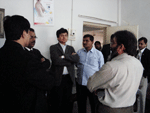
Med Rev Report
In Pakistan, 170,000 Female Sex Workers (FSWs) with 20 clients a month are responsible for having 4.08 billion exposures out of which about 60% or 2.45 billion are without condoms. This calls for a very close scrutiny of this group.
The survey is being done under the supervision of Dr. Sohail Abbas who is the most qualified surveillance expert in the country under whose guidance surveillance work for five years was conducted all over the country.
Although, HIV infection rates among FSWs remains very low but there is substantial evidence of sexual networking between FSWs and other high risk groups according to the findings of Round 2. Overall, approximately 2.3 percent of FSWs reported that they injected drugs. About 10 percent of FSWs reported having sex with an Injecting Drug User (IDU) and 22 percent of IDUs reported having paid FSWs for sex in the past six months. In the presence of prevailing high risk behaviours, low knowledge of HIV/AIDS, increasing HIV prevalence among IDUs, MSWs and HSWs and overlap between high risk sexual networks therefore there is high chances of infection’s spill-over into FSWs and their clients.
Since last two years FSW were not included in the surveillance round. Now reports about contacts between FSWs and IDUs as well as the limited use of condoms on a permanent basis among FSWs is raising concern by NACP and PAPS as well as the donors. Present special round is being support by UNAIDS and UNFPA on the initiative of NACP.
Further, in earlier surveillance rounds, although no significant number of FSWs are reported to be HIV positive yet some of the individual NGOs working with HRGs claims that they have found a number of FSWs (say in Faislabad) who are HIV positive. It is true that independent scientific studies done by FHI and LS do not report any major differences in data than the one presented by HASP studies but nevertheless, there is a need to verify those claims especially when two years have already passed since surveillance was done for this group. There is also a need to look more closely at any other group/category of FSWs which may have been missed out so far.
